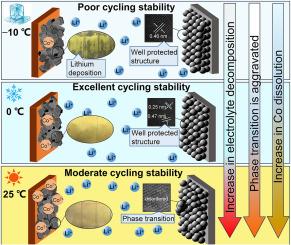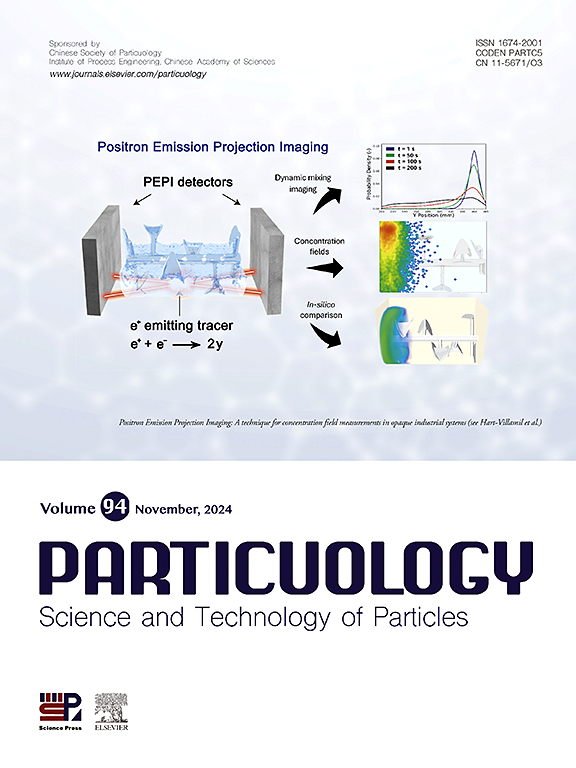Mechanisms for different cyclabilities of commercial LiCoO2/artificial graphite pouch cells at −10, 0, and 25 °C
IF 4.1
2区 材料科学
Q2 ENGINEERING, CHEMICAL
引用次数: 0
Abstract
Although a few studies reveal the reasons of poor charge-discharge abilities for lithium-ion batteries based on LiNixMnyCo1-x-yO2 at low temperature, there are still some practical issues worthy of further investigation. For instance, how the side reactions affect the cyclabilities of commercial LiCoO2/artificial graphite (LCO/AG) cells at different low temperatures, and are the synergistic effects between the side reactions similar to that at room temperature? To answer the issues, the performances of a ⁓3 Ah LCO/AG pouch cell at different temperatures and C-rates are studied. Results illustrate that the obvious increase in charge transferring impedance especially in AG anode at low temperature causes large polarization, then reducing charge-discharge ability and even yielding lithium deposition at −10 °C and 0.5C under 3−4.45 V. Different from at room temperature, the side reactions such as electrolyte decomposition and electrode structural evolution reduce significantly at low temperature, which contribute to an excellent cyclability after 500 cycles at 0 °C. Instead, a series of chain reactions cause a relative lower cyclability at 25 °C. Lithium deposition is slight after 5 cycles at −10 °C, but become considerably severe after 20 cycles and cause rollover failure of capacity. All these results deepen the understanding on mechanisms for different behaviors of LCO/AG cells at low temperature and provide optimization direction.

商用钴酸锂/人造石墨袋电池在 -10、0 和 25 °C 下不同循环能力的机理
尽管一些研究揭示了基于镍钴锰酸锂-x-二氧化钛的锂离子电池在低温下充放电能力差的原因,但仍有一些实际问题值得进一步研究。例如,副反应如何影响商用钴酸锂/人造石墨(LCO/AG)电池在不同低温下的循环能力?为了回答这些问题,我们研究了⁓3 Ah LCO/AG 袋式电池在不同温度和 C 率下的性能。结果表明,在-10 °C和0.5 °C、3-4.45 V电压条件下,低温下电荷转移阻抗(尤其是 AG 阳极)明显增加,导致极化较大,进而降低充放电能力,甚至产生锂沉积。与室温下不同的是,低温下电解质分解和电极结构演变等副反应显著减少,这有助于在 0 °C 下循环 500 次后获得极佳的循环能力。相反,在 25 °C时,一系列连锁反应导致循环能力相对较低。在-10 °C下循环 5 次后,锂沉积轻微,但循环 20 次后,锂沉积变得相当严重,并导致容量翻转失效。所有这些结果加深了人们对 LCO/AG 电池在低温下的不同行为机理的理解,并为优化提供了方向。
本文章由计算机程序翻译,如有差异,请以英文原文为准。
求助全文
约1分钟内获得全文
求助全文
来源期刊

Particuology
工程技术-材料科学:综合
CiteScore
6.70
自引率
2.90%
发文量
1730
审稿时长
32 days
期刊介绍:
The word ‘particuology’ was coined to parallel the discipline for the science and technology of particles.
Particuology is an interdisciplinary journal that publishes frontier research articles and critical reviews on the discovery, formulation and engineering of particulate materials, processes and systems. It especially welcomes contributions utilising advanced theoretical, modelling and measurement methods to enable the discovery and creation of new particulate materials, and the manufacturing of functional particulate-based products, such as sensors.
Papers are handled by Thematic Editors who oversee contributions from specific subject fields. These fields are classified into: Particle Synthesis and Modification; Particle Characterization and Measurement; Granular Systems and Bulk Solids Technology; Fluidization and Particle-Fluid Systems; Aerosols; and Applications of Particle Technology.
Key topics concerning the creation and processing of particulates include:
-Modelling and simulation of particle formation, collective behaviour of particles and systems for particle production over a broad spectrum of length scales
-Mining of experimental data for particle synthesis and surface properties to facilitate the creation of new materials and processes
-Particle design and preparation including controlled response and sensing functionalities in formation, delivery systems and biological systems, etc.
-Experimental and computational methods for visualization and analysis of particulate system.
These topics are broadly relevant to the production of materials, pharmaceuticals and food, and to the conversion of energy resources to fuels and protection of the environment.
 求助内容:
求助内容: 应助结果提醒方式:
应助结果提醒方式:


